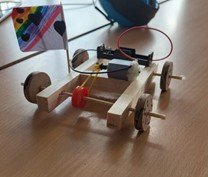Design and Technology
Our Vision and Aims for Design and Technology
Design and technology develops children’s skills and knowledge in design, structures, mechanisms, electrical control and a range of materials, including food. It encourages children's creativity and encourages them to think about important issues.
At Olive Hill, we follow the National Curriculum for design and technology (2014). Its main aims to ensure that all pupils:
Develop the creative, technical and practical expertise needed to perform everyday tasks confidently and to participate successfully in an increasingly technological world;
Build and apply a repertoire of knowledge, understanding and skills in order to design and make high-quality prototypes and products for a wide range of users;
Critique, evaluate and test their ideas and products and the work of others;
Understand and apply the principles of nutrition and learn how to cook.
Our design and technology curriculum is built around an iterative design process. Children are taught to evaluate existing products and determine how they work. This allows the children to design and make functional products for a particular purpose and user. Throughout the design process, the children are supported to develop their critical thinking skills by evaluating, testing and developing the product at each stage of the design process.
At Olive Hill, we ensure design and technology develops children’s skills through collaborative working and problem-solving opportunities. They are taught to be creative and innovative, and are actively encouraged to think about important issues such as sustainability and enterprise. Design and technology allows children to learn how to take risks, becoming resourceful, innovative and capable citizens. Our main priority is to ensure our children become problem solvers who are not afraid of making mistakes.
The skills learned in design and technology also help with learning across the curriculum. For example, knowledge about the properties of materials helps in science and the practice of measuring accurately helps in maths. The curriculum also develops a knowledge of computing through the children’s use of computer control. There are also links to English, art and PSHE.
Design and technology brings learning to life. It also provides a firm basis for later learning in the subject and a platform for developing practical skills. Our children are the future generation who will live in a rapidly changing and evolving society, where STEM subjects (science, technology, engineering and maths) will be pivotal for future industries and technologies.







